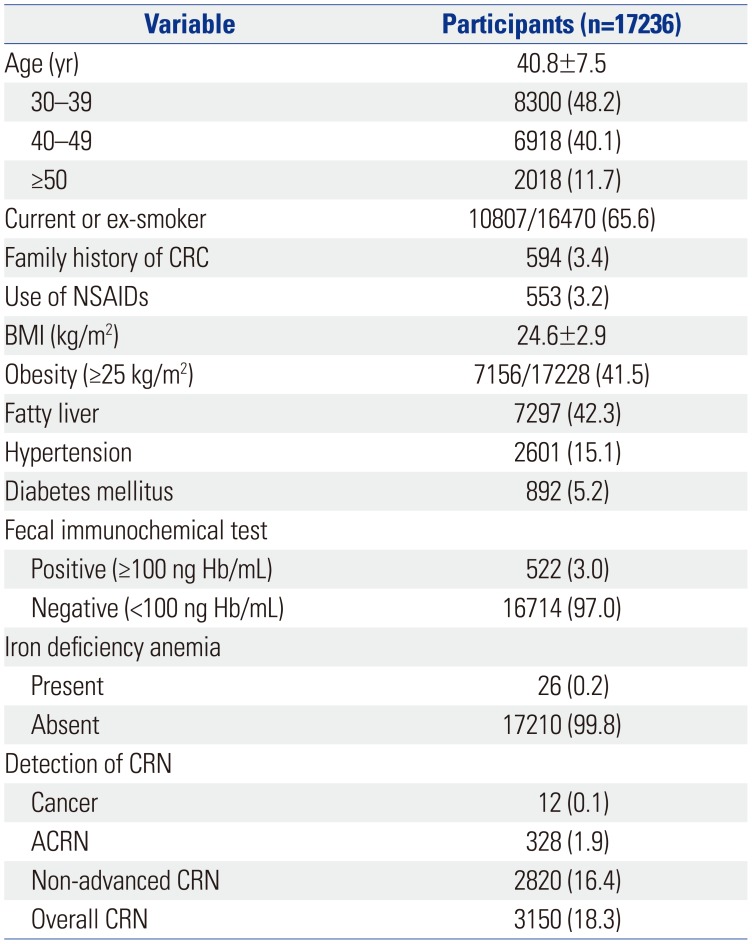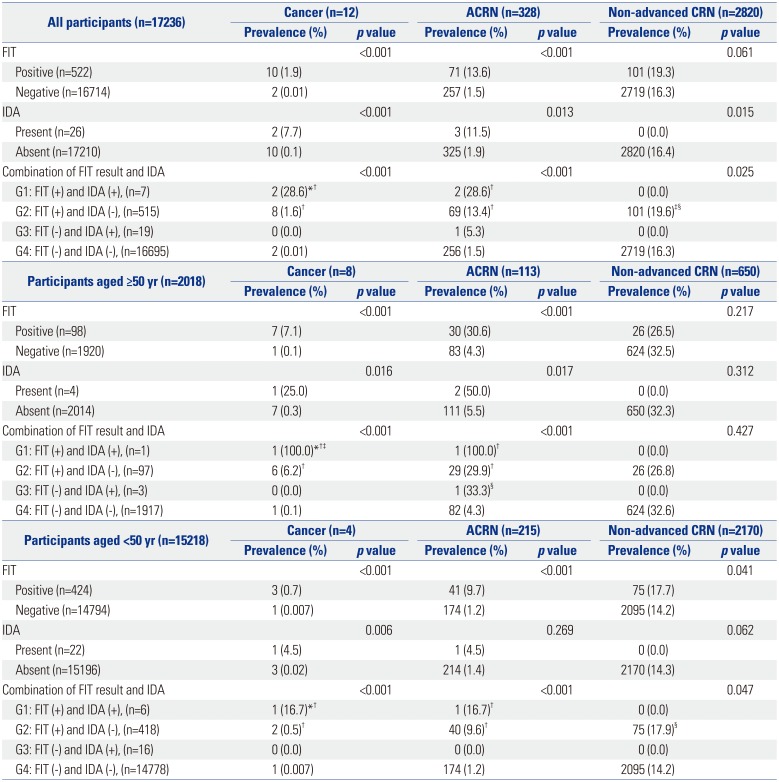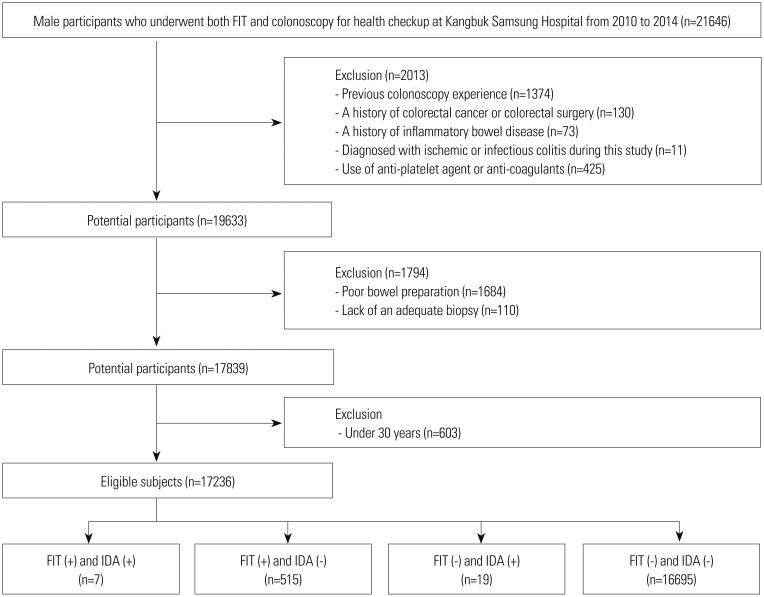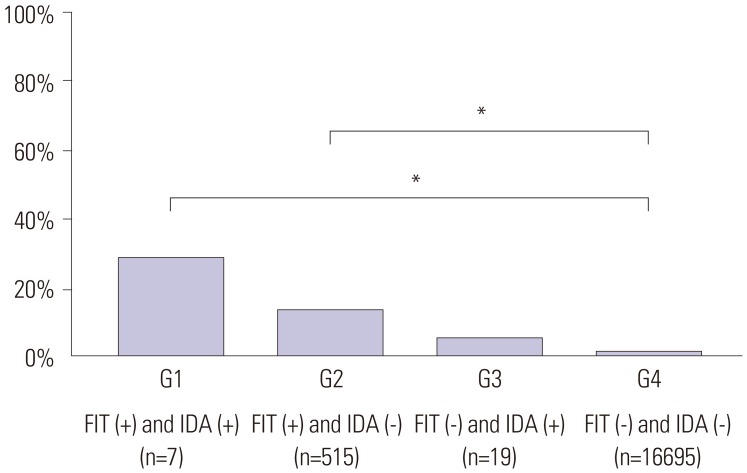1. Guralnik JM, Eisenstaedt RS, Ferrucci L, Klein HG, Woodman RC. Prevalence of anemia in persons 65 years and older in the United States: evidence for a high rate of unexplained anemia. Blood. 2004; 104:2263–2268. PMID:
15238427.

2. World Health Organization. Iron Deficiency Anaemia Assessment, Prevention and Control: A guide for programme managers. Geneva: World Health Organization;2001.
3. McIntyre AS, Long RG. Prospective survey of investigations in outpatients referred with iron deficiency anaemia. Gut. 1993; 34:1102–1107. PMID:
8174963.

4. Looker AC, Dallman PR, Carroll MD, Gunter EW, Johnson CL. Prevalence of iron deficiency in the United States. JAMA. 1997; 277:973–976. PMID:
9091669.

5. Andrews NC. Disorders of iron metabolism. N Engl J Med. 1999; 341:1986–1995. PMID:
10607817.

6. Rockey DC. Occult gastrointestinal bleeding. N Engl J Med. 1999; 341:38–46. PMID:
10387941.

7. Goddard AF, James MW, McIntyre AS, Scott BB. British Society of Gastroenterology. Guidelines for the management of iron deficiency anaemia. Gut. 2011; 60:1309–1316. PMID:
21561874.

8. Lindsay JO, Robinson SD, Jackson JE, Walters JR. The investigation of iron deficiency anemia--a hospital based audit. Hepatogastroenterology. 1999; 46:2887–2890. PMID:
10576367.
9. Harris GJ, Simson JN. Causes of late diagnosis in cases of colorectal cancer seen in a district general hospital over a 2-year period. Ann R Coll Surg Engl. 1998; 80:246–248. PMID:
9771221.
10. Goodman D, Irvin TT. Delay in the diagnosis and prognosis of carcinoma of the right colon. Br J Surg. 1993; 80:1327–1329. PMID:
8242314.

11. Cook IJ, Pavli P, Riley JW, Goulston KJ, Dent OF. Gastrointestinal investigation of iron deficiency anaemia. Br Med J (Clin Res Ed). 1986; 292:1380–1382.

12. Rockey DC, Auslander A, Greenberg PD. Detection of upper gastrointestinal blood with fecal occult blood tests. Am J Gastroenterol. 1999; 94:344–350. PMID:
10022627.

13. Kim NH, Park JH, Park DI, Sohn CI, Choi K, Jung YS. Are hemorrhoids associated with false-positive immunochemical test results? Yonsei Med J. 2017; 58:150–157. PMID:
27873508.
14. Levin B, Lieberman DA, McFarland B, Andrews KS, Brooks D, Bond J, et al. Screening and surveillance for the early detection of colorectal cancer and adenomatous polyps, 2008: a joint guideline from the American Cancer Society, the US Multi-Society Task Force on Colorectal Cancer, and the American College of Radiology. Gastroenterology. 2008; 134:1570–1595. PMID:
18384785.

15. Young GP, Symonds EL, Allison JE, Cole SR, Fraser CG, Halloran SP, et al. Advances in fecal Oocult blood tests: the FIT revolution. Dig Dis Sci. 2015; 60:609–622. PMID:
25492500.
16. Carroll MR, Seaman HE, Halloran SP. Tests and investigations for colorectal cancer screening. Clin Biochem. 2014; 47:921–939. PMID:
24769265.

17. Nakama H, Zhang B, Fattah AS, Zhang X. Colorectal cancer in iron deficiency anemia with a positive result on immunochemical fecal occult blood. Int J Colorectal Dis. 2000; 15:271–274. PMID:
11151429.
18. Cilona A, Zullo A, Hassan C, Ridola L, Annese M. Is faecal-immunochemical test useful in patients with iron deficiency anaemia and without overt bleeding? Dig Liver Dis. 2011; 43:1022–1024. PMID:
21900058.

19. Soweid AM, Kobeissy AA, Jamali FR, El-Tarchichi M, Skoury A, Abdul-Baki H, et al. A randomized single-blind trial of standard diet versus fiber-free diet with polyethylene glycol electrolyte solution for colonoscopy preparation. Endoscopy. 2010; 42:633–638. PMID:
20623443.

20. Wen CP, David Cheng TY, Tsai SP, Chan HT, Hsu HL, Hsu CC, et al. Are Asians at greater mortality risks for being overweight than Caucasians? Redefining obesity for Asians. Public Health Nutr. 2009; 12:497–506. PMID:
18547457.

21. Camaschella C. Iron-deficiency anemia. N Engl J Med. 2015; 372:1832–1843. PMID:
25946282.

22. Fraser CG, Allison JE, Halloran SP, Young GP. Expert Working Group on Fecal Immunochemical Tests for Hemoglobin, Colorectal Cancer Screening Committee, World Endoscopy Organization. A proposal to standardize reporting units for fecal immunochemical tests for hemoglobin. J Natl Cancer Inst. 2012; 104:810–814. PMID:
22472305.

23. Lieberman DA, Rex DK, Winawer SJ, Giardiello FM, Johnson DA, Levin TR; United States Multi-Society Task Force on Colorectal Cancer. Guidelines for colonoscopy surveillance after screening and polypectomy: a consensus update by the US Multi-Society Task Force on Colorectal Cancer. Gastroenterology. 2012; 143:844–857. PMID:
22763141.

24. Kwah J, Schroy PC 3rd, Jacobson BC, Calderwood AH. Whites and blacks have similar risk of metachronous advanced colorectal neoplasia. Dig Dis Sci. 2014; 59:2264–2271. PMID:
24700155.

25. Short MW, Domagalski JE. Iron deficiency anemia: evaluation and management. Am Fam Physician. 2013; 87:98–104. PMID:
23317073.
26. Johnson-Wimbley TD, Graham DY. Diagnosis and management of iron deficiency anemia in the 21st century. Therap Adv Gastroenterol. 2011; 4:177–184.

27. Young CJ, Sweeney JL, Hunter A. Implications of delayed diagnosis in colorectal cancer. Aust N Z J Surg. 2000; 70:635–638. PMID:
10976891.

28. Gonzalez-Hermoso F, Perez-Palma J, Marchena-Gomez J, Lorenzo-Rocha N, Medina-Arana V. Can early diagnosis of symptomatic colorectal cancer improve the prognosis? World J Surg. 2004; 28:716–720. PMID:
15383871.

29. Stapley S, Peters TJ, Sharp D, Hamilton W. The mortality of colorectal cancer in relation to the initial symptom at presentation to primary care and to the duration of symptoms: a cohort study using medical records. Br J Cancer. 2006; 95:1321–1325. PMID:
17060933.

30. Teng CL, Yu JT, Chen YH, Lin CH, Hwang WL. Early colonoscopy confers survival benefits on colon cancer patients with pre-existing iron deficiency anemia: a nationwide population-based study. PLoS One. 2014; 9:e86714. PMID:
24466209.

31. Droogendijk J, Beukers R, Berendes PB, Tax MG, Sonneveld P, Levin MD. Screening for gastrointestinal malignancy in patients with iron deficiency anemia by general practitioners: an observational study. Scand J Gastroenterol. 2011; 46:1105–1110. PMID:
21726115.

32. Capurso G, Baccini F, Osborn J, Panzuto F, Di Giulio E, Delle Fave G, et al. Can patient characteristics predict the outcome of endoscopic evaluation of iron deficiency anemia: a multiple logistic regression analysis. Gastrointest Endosc. 2004; 59:766–771. PMID:
15173787.

33. Lucas CA, Logan EC, Logan RF. Audit of the investigation and outcome of iron-deficiency anaemia in one health district. J R Coll Physicians Lond. 1996; 30:33–36. PMID:
8745360.
34. Saito H. Screening for colorectal cancer by immunochemical fecal occult blood testing. Jpn J Cancer Res. 1996; 87:1011–1024. PMID:
8957057.

35. Inra JA, Syngal S. Colorectal cancer in young adults. Dig Dis Sci. 2015; 60:722–733. PMID:
25480403.

36. Bailey CE, Hu CY, You YN, Bednarski BK, Rodriguez-Bigas MA, Skibber JM, et al. Increasing disparities in the age-related incidences of colon and rectal cancers in the United States, 1975-2010. JAMA Surg. 2015; 150:17–22. PMID:
25372703.








 PDF
PDF ePub
ePub Citation
Citation Print
Print




 XML Download
XML Download